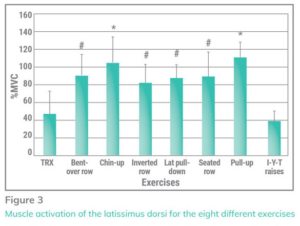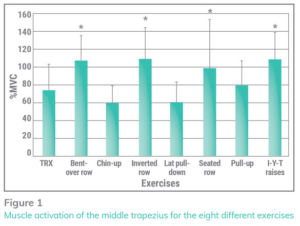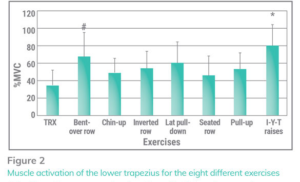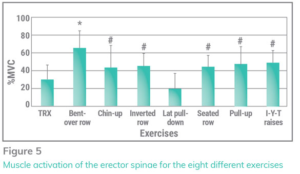CABLE/PULLEY & MACHINE ROWS
Click on Image to Enlarge
MOMENT ARM & EMG STUDY
LATISSIMUS DORSI MIDDLE REGION, UPPER & LOWER ERECTOR SPINAE
JOINT COMPRESSION, AXIAL TWIST & FLEXION-EXT MUSCULAR STIFFNESS
– Inverted Body Row, Standing 1-Arm Cable Row, BB Row
Comparison of Different Rowing Exercises: Trunk Muscle Activation and Lumbar Spine Motion, Load, and Stiffness – 2009 – Fenwick, McGill
Procedures
– matched the loading between exercises relative to inverted row
Electrode Placement
– Latissimus Dorsi: over the muscle belly when the arm was positioned in the shoulder mid-range
Results
Latissimus Dorsi – Middle: inverted row 80% · standing 1-arm cable row 70% · bent over bb row 55%
+ Upper erector Spinae: inverted row 60% · bent over bb row 50% · standing 1-arm cable row 50%
+ Lower erector Spinae: bent over bb row 40% · inverted row 30% · standing 1-arm cable row 20%
Results – Figure 4 below
Joint Compression: bent over bb row · standing 1-arm cable row · inverted row
– the compromised spine angle and large moment caused by the load in the hand contributed to the high joint compression
Result Figure 5 below
Axial Twist Muscular Stiffness: standing 1-arm cable row · bent over bb row · inverted row
Flexion/Extension Muscular Stiffness: bent-over bb row · inverted row · standing 1-armed cable row
– Due to compromised spine posture and large low back moment, the spine must increase stiffness to maintain its stability
EMG STUDIES
LATISSIMUS DORSI, UPPER-MIDDLE-LOWER TRAPS & BICEPS
– Seated Cable Row, BB Row, Lat Pulldown, Upright Row
EMG of the biceps brachii, latissimus dorsi, and trapezius muscles during 5 pull exercises – 2005 – Handa
 Procedure & Universal Machine Exercises
Procedure & Universal Machine Exercises
– compare 5 different pull movements; 8 weight-trained men
Universal Machine Exercises
1. Lat Pulldown: medium pronated grip
2. Bent over Row: medium pronated grip
3. Seated Cable Row: narrow pronated grip
4. Upright Row: medium pronated grip
Results – 3 reps @70%RM
Note: I don’t know where the electrodes were placed for the latissimus dorsi
Trapezius – Upper: upright row 82% · bent over row 78% · seated cable row 42% · lat pulldown 29%
Trapezius – Middle: bent over row 90% · seated cable row 66% · upright row 66% · lat pulldown 48%
Trapezius – Lower: bent over row 87% · upright row 67% · seated cable row 56% · lat pulldown 55%
Latissimus Dorsi: seated cable row 82% · lat pulldown 78% · bent over row 64% · upright row 14%
+ Biceps Brachii: upright row 92% · lat pulldown 64% · bent over row 44% · seated cable row 41%
MIDDLE TRAPEZIUS, UPPER LATS, BICEPS
– Lat Pulldowns vs. Seated Rows
Variations in muscle activation levels during traditional latissimus dorsi weight training exercises – 2004 – Lehman
Subjects
– 12 healthy males average age 27; >6 months of weight training experience
Electrode Placement
– Biceps Brachii: middle of the muscle belly when the elbow was flexed at 90 degrees
– Latissimus Dorsi: one cm lateral to the inferior border of the right scapula
– Middle Trapezius and Rhomboid Minor: between the spine of the scapula and the 2nd thoracic spinous process
Exercises
1. Wide Pronated Grip Pulldown: 150% shoulder width; arms 90º shoulder flexion; 90º elbow flexion. (1–2″ above eye level); hold 10 secs
2. Reverse (Supinated) Grip Pulldown: 100% shoulder width; arms 90º shoulder forward flexion; 90º elbow flexion (1–2″ above eye level); hold 10 secs
3. Seated Row, shoulders retracted: mid pronated grip 6″ apart; shoulder 0º flexion; 90º elbow flexion; maximal scapular retraction; hold 10 secs
4. Seated Row, shoulders slack: same movement as exercise #3 except allowing the scapula to roll forward during the isometric hold portion of the exercise
Results – MVIC
Note: same weight was used for all 4 exercises
Upper Latissimus Dorsi: seated row + retraction 37% · seated row 30% · pronated grip lat pull 26% · supinated grip lat pull 22%
Middle Trapezius/Rhomboids: seated row + retraction 35% · seated row 30% · pronated grip lat pull 27% · supinated grip lat pull 20%
+ Biceps Brachii: supinated grip lat pull 20% · seated row + retraction 20% · seated row 18% · pronated grip lat pull 15%
UPPER LATS, INFRASPINATUS, MIDDLE-LOWER TRAPS & ERECTOR SPINAE
– Seated Cable Row, Inverted Body Row, Prone LYT, BB Row
– Lat Pulldown, Chinup, Pullup
What is the best back exercise? – 2018 – Edelburg – PDF Link to Edelburg Thesis .
Procedure
– 19 males; resistance-trained; 5 reps @70% 1RM or bodywt; rest 2min; exercises performed in random order
Exercises
Lat Pull: overhand grip, medium width; pull shoulder blades down & back; lean back slightly; pull bar to top of chest
Pullup: shoulder width overhand grip, pull shoulders back & down, elbows down toward sides, chin level with the bar
Bent-over BB Row: shoulder width overhand grip; pulled toward the sternum keeping a flat back
Inverted Row: straight bar; medium-width grip; shoulder blades retracted at finish
Seat Row: V-bar handle; feet on platform, knees bent, straight back; chest up; pull until handle touched front of stomach
TRX Row: pulled scapula down and back; elbows tight; palms facing inward; standing with one foot ahead of the other; leaning backward while shifting body weight over back leg; shoulders rolled forward
Prone “I” face down on bench; arms straight overhead; palms facing inward; retracting scapulae
Prone “Y” face down on bench; arms at 45º lifting thumbs toward the ceiling; retracting scapulae
Prone “T” face down on bench; arms at 90º palms facing floor; retracting scapulae
Results MVC
 Latissimus dorsi – Upper Fibers – Extension, adduction, horizontal abduction, and internal rotation of the shoulder
Latissimus dorsi – Upper Fibers – Extension, adduction, horizontal abduction, and internal rotation of the shoulder
· Over 100% – pullup > chinup
· 85% → 82% – bent-over bb row > seated row > lat pulldown > inverted row
· 45% → 40% – TRX > IYT Raises
 Infraspinatus – External rotation of the shoulder (this is one of the rotator cuff muscles)
Infraspinatus – External rotation of the shoulder (this is one of the rotator cuff muscles)
· 58% → 50% – IYT Raises > bent over bb row > pullup > chinup > inverted row
· 40% → 35% – seated row > TRX > lat pulldown
 Middle trapezius – Upward rotation and adduction of the scapulae
Middle trapezius – Upward rotation and adduction of the scapulae
· Over 100% – IYT Raises > bent over bb row > inverted row > seated row
· 80% → 75% – pullup > TRX
· 60% – chinup > lat pulldown
 Lower trapezius – Depression of the scapulae
Lower trapezius – Depression of the scapulae
· 80% –IYT Raises
· 62% → 42% – bent over bb row > lat pulldown > pullup >inverted row > chinup > seated row
· 35% – TRX
 + Erector spinae – Extension and lateral flexion of the spine
+ Erector spinae – Extension and lateral flexion of the spine
· 62% – bent over bb row
· 48% → 40% – IYT Raises > pullup > chinup > inverted row > seated row
· 28% → 20% – TRX > lat pulldown
The effect of bilateral and unilateral row exercises on core muscle activation · 2015 – Saeterbakken; Vidar Andersen
Procedure & Results
– 15 resistance-trained men
Erector spinae:
– bb row 30% · db row 28% ·
– seated cable bilateral 25% · machine bilateral 25% · seated cable unilateral 15% · machine unilateral 12%
Multifidus:
– bb row 22% · db row 22% ·
– machine bilateral 20% · seated cable bilateral 18% · seated cable unilateral 15% · machine unilateral 15%
External oblique:
– db row 25% ·
– seated cable unilateral 15% · machine unilateral 15%
Rectus abdominis:
– no significant differences


